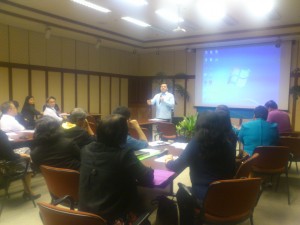
Department of Social Welfare and Development (DSWD) Assistant Secretary Camilo Gudmalin said that the impact of Typhoon Yolanda in the country changed the way the government views poverty alleviation and local development.
Addressing government officials who are members of the National Interagency Preparation and Implementation Team (NIAPIT) for the DSWD’s National Community-Driven Development Program (NCDDP) during a recent meeting, Asec. Gudmalin described ‘Yolanda’ as a “game changer”.
He said that stronger disasters are likely to hit the country again because of climate change, a state which DSWD Secretary Corazon Juliano-Soliman refers to as the “new normal”.
The NCDDP is the scaling up of the operations of Kapit-Bisig Laban sa Kahirapan-Comprehensive and Integrated Delivery of Social Services (Kalahi-CIDSS), one of the core programs of the DSWD.
Originally designed to target poor communities all over the country, the design and coverage of the NCDDP has since been changed to also provide support to the municipalities that were affected by ‘Yolanda’.
Aside from its coverage, in which 554 of its 847 target municipalities are ‘Yolanda’-affected, the design of the NCDDP was also modified to integrate disaster response operations procedures.
Asec. Gudmalin said that responding to the issues of poverty and disaster response, recovery, and rehabilitation requires the strengthening of the overall government approach in order to build resiliency of vulnerable communities.
He emphasized that disaster recovery and rehabilitation initiatives are not solely the government’s responsibility, but should also involve the citizens.
“Central to rehabilitation is the voice of the people because they know what they really need,” he said.
He added, “We need to ask the people and get them to participate in the rehabilitation after ‘Yolanda’.
He said that NCDDP provides a good opportunity for this.
Infrastructures
NCDDP uses the community-driven development (CDD) strategy, a development approach that focuses on empowering and building up the capacities of citizens and local government.
Similar to Kalahi-CIDSS, NCDDP will provide trainings and community grants to villages in order to enable them to identify and implement sub-projects that will address their community’s needs.
In most instances, this comes in the form of small-scale infrastructures such as footpaths, school buildings, health stations, day care centers, sea walls, drainage systems, and soil erosion sub-projects.
Under the NCDDP, communities can also propose sub-projects that will address repairs of damaged structures and shelter assistance for ‘Yolanda’-affected areas.
However, Asec. Gudmalin emphasized that the infrastructures are only one aspect of what the NCDDP offers to communities.
By capacitating the people with skills and mobilizing them to work together as a community, the program will empower them, which will then help them make their local governments more accountable, move toward development, and become more resilient against disasters.
He said, “NCDDP will not only be building infrastructures, it will also be building resiliency.”
“It will be positioned as one of the major programs of the government to rehabilitate ‘Yolanda’-affected areas,” he concluded.
The NCDDP is targeted for launching on May this year.###


